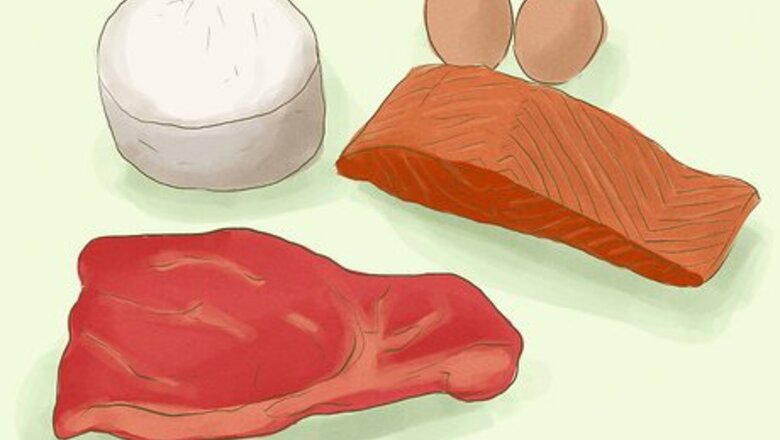
views
X
Expert Source
Dee DineNutrition & Vegan Food Specialist
Expert Interview. 14 October 2020.
It involves eating lots of lean meats and fish, piling veggies on your plate, and cutting out grains, legumes, dairy, sugar, and processed foods. While there are health benefits to any diet based on lean meats, fruits, and vegetables, avoiding grains and dairy could leave gaps in your nutritional requirements. Consult your doctor before starting any diet plan and, if you go paleo, consider taking calcium and vitamin D supplements.[2]
X
Trustworthy Source
PubMed Central
Journal archive from the U.S. National Institutes of Health
Go to source
Choosing Paleo-Approved Foods
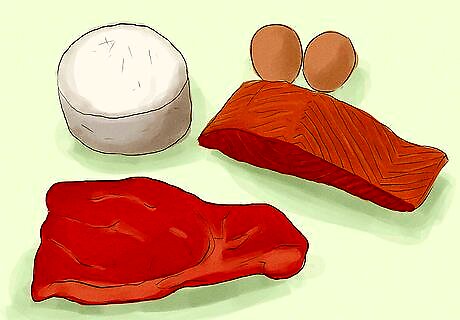
Have 4 to 8 ounces (110 to 230 g) of lean protein with each meal. Between 1/3 and 1/2 of your diet should consist of lean protein sources. Examples include poultry, fish, shellfish, lean cuts of pork and beef, and eggs. Try to have a palm-sized serving of protein with every meal. For instance, include 3 eggs at breakfast, have a salmon fillet over greens for lunch, and eat a boneless, skinless chicken breast with steamed vegetables for dinner. If possible, go for wild-caught fish and shellfish and meats derived from grass-fed animals. Limit your consumption of red meat, since it can increase the risk of heart disease and other health issues. Go for chicken, fish, and other leaner options instead.
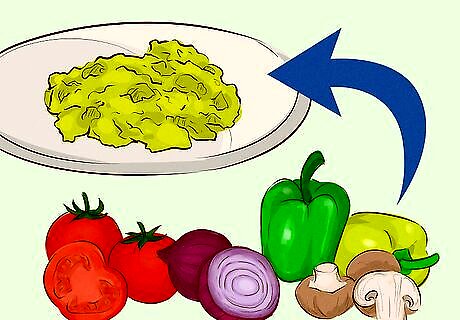
Fill half of your plate with leafy or root vegetables. Pile on 1 to 2 fist-sized portions of veggies with each meal, and try to eat a total of 4 cups (950 mL) daily. Include a variety of vegetable types and colors in your diet, and eat them both raw and cooked. Mix up the veggies you consume every day. Scramble your eggs with spinach and onions in the morning, have mixed greens with cucumber and tomato for lunch, snack on baby carrots, and eat broccoli and peppers at dinner. Stricter paleo diets prohibit starchy vegetables, like potatoes, yams, and squashes. However, many paleo plans allow starchy veggies, and you should still include them in your diet. They're great sources of healthy carbohydrates, potassium, and vitamin B.

Eat a moderate amount of fresh, low-sugar fruits. Include 1 to 3 daily servings of fruit in your diet. Since sweets and foods with added sugar aren't allowed, eating fruit is the best way to satisfy your sweet tooth. While all fresh fruits are paleo-friendly, options that contain less sugar are preferred. Paleo-preferred fruits include berries, bananas, and melons. Canned fruits are processed and contain added sugar, so they're not allowed.
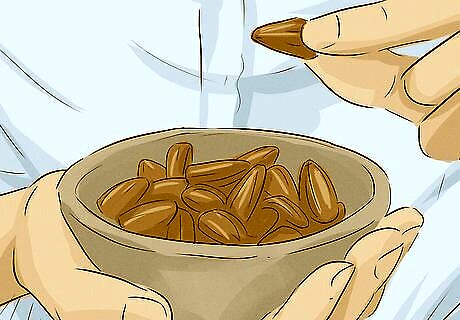
Go for almonds, walnuts, and macadamia nuts instead of peanuts. Unsalted nuts are good sources of protein, healthy fat, and fiber. Have a handful as a midday snack or use them as garnishes or toppings. In addition to being great snack options, nut-based flours, like almond and coconut flour, are good substitutes for wheat-based flours. While nuts are paleo-approved, store-bought nut butters contain added sugar, so they're not allowed. Keep in mind peanuts are actually legumes, so they're not paleo-approved either.

Use olive, avocado, and other natural oils. Choose natural oils instead of salad dressings and other condiments. Avoid butter (since it's a dairy product), margarine, peanut oil, hydrogenated vegetable oils, corn oil, and soybean oil. Stricter paleo diets prohibit cooking with oils that are liquid at room temperature, such as olive, avocado, and macadamia oils. Instead, they allow cooking with coconut oil and animal-derived fats. Medical professionals suggest liquid oils are healthier than solid oils and animal fats, so you might want to limit your use of coconut oil, lard, and other solid options.

Avoid grains, legumes, dairy, refined sugar, and processed foods. Grain products include bread, cereals, rice, and pasta. Legumes, such as peas, beans, and soybeans, are also prohibited. Additionally, you'll need to avoid sweets, canned foods, and processed meats, such as bacon and deli meats. While dairy products, like milk and yogurt, aren't paleo-approved, some people choose to include them in order to meet calcium and vitamin D requirements. If you do cut dairy, you should take calcium and vitamin D supplements daily. Almond milk fortified with these nutrients could be a good substitute for dairy milk, but stricter paleo diets categorize store-bought almond milk as a processed product.
Creating a Meal Plan

Plan and prep your meals ahead of time. Knowing what you'll be eating ahead of time will help you manage your nutritional needs and stick to your diet. Plan your meals for the week or for the next 2 or 3 days, and prep items in advance to save time. For example, chop and portion veggies on Sunday night for your meals Monday through Wednesday.

Write down your daily meal plans to stay organized. For instance, your daily meals could be: Breakfast: frittata with spinach and tomato. Lunch: Cobb salad with chicken breast, lettuce, tomato, cucumber, onion, and avocado. Snack: Diced cantaloupe. Dinner: Baked salmon fillet with steamed broccoli and sauteed mushrooms. Dessert: sliced banana with strawberries, pureed blueberries, and slivered almonds.
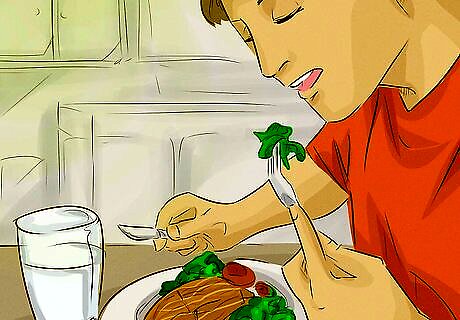
Eat when you're hungry until you feel full. Plan what your meals will be to ensure you'll stick to your diet, but don't keep a strict meal schedule or eat when you're not hungry. Part of the paleo lifestyle is to eat when you need to instead of sticking to a strict meal schedule. You shouldn't still be hungry after eating, so eat until you're full. If you're still peckish after a meal, just have another helping of veggies.

Find new recipes online or in cookbooks to mix up your routine. Search online for free recipes or invest in paleo cookbooks. Using paleo-approved recipes will make it easier to plan your meals, and you might find paleo versions of your favorite meals. Trying new recipes can make your diet more exciting and easier to maintain.
Sticking to Your Diet
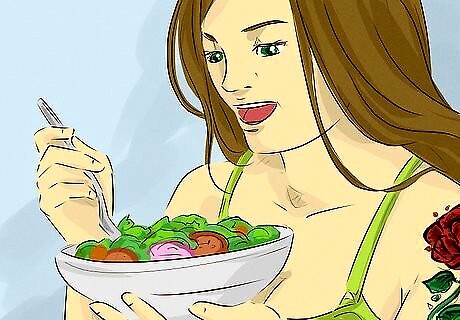
Take baby steps to get used to eating paleo. Try cutting grains one week, sweets the next, then dairy the week after that. Easing yourself into your new diet can help you adapt. Additionally, if you cut foods gradually, you won't have to throw away prohibited items in your fridge and pantry. Easing yourself into your diet can also get your digestive system used to the transition. Adding lots of meat and veggies to your diet all of a sudden could lead to gas, bloating, and changes in your bowel movements.

Try dieting with another person and hold each other accountable. Talk to friends and family members about going paleo with you. After starting the diet, check in with each other daily to offer encouragement. Make it fun by exchanging recipes, cooking together, and going grocery shopping together.

Buy cheaper cuts of meat, sale items, and seasonal ingredients. Since the paleo diet is packed with protein and fresh produce, cost could be a major factor. Shop for deals, take advantage of sales, and go for seasonal fruits and vegetables, which are usually cheaper than off-season items. Inexpensive cuts of meat, like chuck roast or shanks, can still be delicious if you cook them properly. Throw a chuck roast, onions, and carrots in the slow cooker before you go to work. You'll come home to a delicious, tender dinner, and the leftovers will hold you over for days.

Check menus in advance when you go out to eat. It's a lot harder to stick to your diet when you have to decide what to eat on the fly. When you go out to eat, look up the menu online and search for paleo-friendly options, like salads and meat or fish served with veggies. If an entree comes with rice or prohibited item, call ahead and ask if you can substitute it with a steamed vegetable.
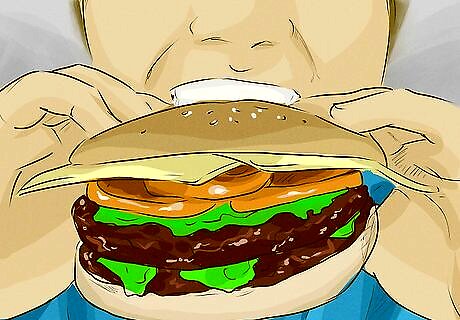
Give yourself a few regular cheat meals. Some paleo plans allow 1 to 3 cheat meals per week to help dieters stay on the wagon. Give yourself permission to have a scoop of ice cream, cheeseburger with a bun, or another favorite item that's not paleo-approved.

Watch out for symptoms of nutritional deficiencies. Cutting out grains, legumes, and diary can lead to calcium, vitamin B, and vitamin D deficiencies. Symptoms include weakness, fatigue, nausea, headache, difficulty healing, getting sick often, numbness or strange sensations, and dizziness. If you experience any of these symptoms, stop the diet and consult your doctor about meeting your nutritional needs. They might recommend dietary changes and a short-term supplement to overcome the deficiency.




















Comments
0 comment